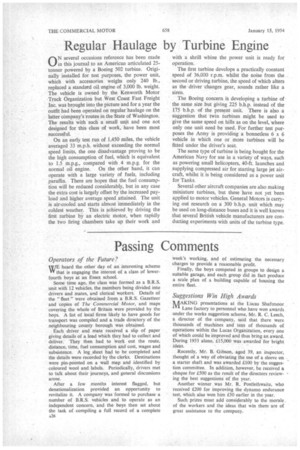Regular Haulage by Turbine Engine
Page 28

If you've noticed an error in this article please click here to report it so we can fix it.
ON several occasions reference has been made this journal to an American articulated 25tonner powered by a Boeing 502 turbine. Originally installed for test purposes, the power unit, which with accessories weighs only 240 lb., replaced a standard oil engine of 3,000 lb. weight. The vehicle is owned by the Ken worth Motor Truck Organization but West Coast Fast Freight Inc. was brought into the picture and for a year the outfit had been operated on regular haulage on the latter company's routes in the State of Washington. The results with such a small unit and one not designed for this class of work, have been most successful.
On an early test run of 1,450 miles, the vehicle averaged 33 m.p.h. without exceeding the normal speed limits, the one disadvantage proving to be the high consumption of fuel, which is equivalent to 1.5 m.p.g., compared with 4 m.p.g. for the normal oil engine. On the other hand, it can operate with a large variety of fuels, including paraffin. . There are hopes that the fuel consumption will be reduced considerably, but in any case the extra cost is largely offset by the increased payload and higher average speed attained. The unit is air-cooled and starts almost immediately in the coldest weather. This is achieved by driving the first turbine by an electric motor, when rapidly the two firing chambers take up their work and with a shrill whine the power unit is ready for operation.
The first turbine develops a practically constant speed of 36,000 r.p.m. whilst the noise from the second or driving turbine, the speed of which alters as the driver changes gear,. sounds rather like a siren.
• The Boeing concern, is developing a .turbine of the same size but giving 225 b.h.p. instead of the 175 b.h.p. of the present unit. There is also a suggestion that twin turbines might be used to give the same speed on hills as on the level, where only one unit need be used. For further test purposes the Army is providing a bonnetless 6 x 6 vehicle in which one or more turbines will be fitted under the driver's seat.
The same type of turbine is being bought for the American Navy for use in a variety of ways, such as powering small helicopters, 40-ft. launches and supplying compressed air for starting large jet aircraft, whilst it is being considered as a power unit for Tanks.
Several other aircraft companies are also making miniature turbines, but these have not yet been applied to motor vehicles. General Motors is carrying out research on a 300 b.h.p. unit which may be used on long-distance buses and it is well known that several British vehicle manufacturers are conducting experiments with units of the turbine type.




































































































